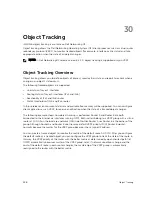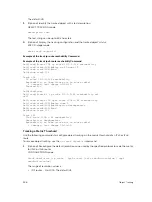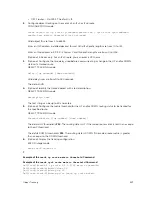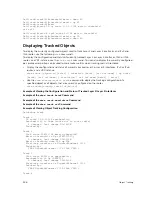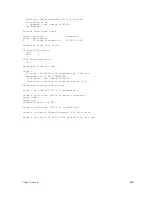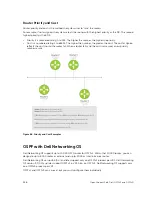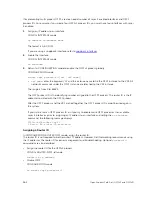
The backbone is the only area with a default area number. All other areas can have their Area ID assigned
in the configuration.
In the previous example, Routers A, B, C, G, H, and I are the Backbone.
• A stub area (SA) does not receive external route information, except for the default route. These areas
do receive information from inter-area (IA) routes.
NOTE: Configure all routers within an assigned stub area as stubby, and not generate LSAs that
do not apply. For example, a Type 5 LSA is intended for external areas and the Stubby area
routers may not generate external LSAs. A virtual link cannot traverse stubby areas.
• A not-so-stubby area (NSSA) can import AS external route information and send it to the backbone. It
cannot receive external AS information from the backbone or other areas. However, a virtual link can
traverse it.
• Totally stubby areas are referred to as no summary areas in the Dell Networking OS.
Networks and Neighbors
As a link-state protocol, OSPF sends routing information to other OSPF routers concerning the state of
the links between them. The state (up or down) of those links is important.
Routers that share a link become neighbors on that segment. OSPF uses the Hello protocol as a neighbor
discovery and keep alive mechanism. After two routers are neighbors, they may proceed to exchange and
synchronize their databases, which creates an adjacency.
Router Types
Router types are attributes of the OSPF process.
A given physical router may be a part of one or more OSPF processes. For example, a router connected
to more than one area, receiving routing from a border gateway protocol (BGP) process connected to
another AS acts as both an area border router and an autonomous system router.
Each router has a unique ID, written in decimal format (A.B.C.D). You do not have to associate the router
ID with a valid IP address. However, to make troubleshooting easier, Dell Networking recommends that
the router ID and the router’s IP address reflect each other.
The following example shows different router designations.
552
Open Shortest Path First (OSPFv2 and OSPFv3)
Summary of Contents for Z9000
Page 1: ...Dell Configuration Guide for the Z9000 System 9 7 0 0 ...
Page 80: ...grub reboot 80 Management ...
Page 128: ... 0 Te 1 1 Te 1 2 rx Flow N A N A 128 Access Control Lists ACLs ...
Page 491: ...Figure 70 Configuring OSPF and BGP for MSDP Multicast Source Discovery Protocol MSDP 491 ...
Page 496: ...Figure 73 MSDP Default Peer Scenario 1 496 Multicast Source Discovery Protocol MSDP ...
Page 497: ...Figure 74 MSDP Default Peer Scenario 2 Multicast Source Discovery Protocol MSDP 497 ...
Page 498: ...Figure 75 MSDP Default Peer Scenario 3 498 Multicast Source Discovery Protocol MSDP ...
Page 760: ...Figure 100 Single and Double Tag TPID Match 760 Service Provider Bridging ...
Page 761: ...Figure 101 Single and Double Tag First byte TPID Match Service Provider Bridging 761 ...

